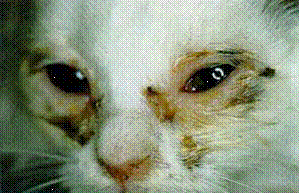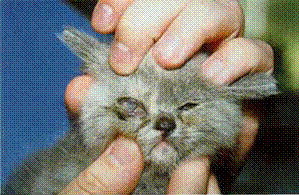Can Cats Get Uri From Other Animals
True cat flu, or upper respiratory infection (URI) is a very common affliction that tin can vary considerably in severity, and on occasions tin even be life-threatening.
In the vast majority of cases, disease results from infection with feline calicivirus (FCV) or feline herpes virus (FHV, or FHV-1). Clinical signs include sneezing, nasal discharge, conjunctivitis (inflammation of the lining of the optics), ocular discharge, loss of appetite, fever and low. Mouth ulcers, coughing, excessive drooling of saliva and centre ulcers may also be seen. Very young, very old and immunosuppressed cats are more likely to develop severe disease and possibly die as a effect of their URI, usually due to secondary infections (such as pneumonia), lack of nutrition and dehydration.

Typical ocular and nasal discharges of true cat flu

Infection with feline herpes virus can crusade serious middle damage
What cats are at risk of URIs?
URIs are mutual, as the causative viruses are widespread in true cat populations. Typical risk factors include:
- Cats kept in large groups or colonies such every bit breeding catteries, rescue centres and feral cat colonies – in these situations the viruses are able to spread easily
- Unvaccinated cats
- Kittens
- Elderly and immunosuppressed cats (e.g., cats with FeLV or FIV infection, or cats receiving immunosuppressive therapy) are more than vulnerable to developing severe disease
Causes of URIs in cats
Most cat URIs are caused by infection with one or both of the cat flu viruses:
- Feline canker virus (FHV or FHV-ane, formerly known as feline rhinotracheitis virus)
- Feline calicivirus (FCV)
These 2 viruses are idea to exist responsible for more than 90% of URIs in cats. Other important organisms that may be involved in some cases include:
- Bordetella bronchiseptica (may be a cause of sneezing, nasal discharge and sometimes cough – of import in some colony situations)
- Chlamydophila felis (this is mainly a cause of ocular disease – conjunctivitis)
Clinical signs of URI
The incubation period following infection with FCV or FHV is usually merely a few days (two-ten days). After this, typical clinical signs develop which include:
- Sneezing
- Nasal discharge
- Ocular belch
- Sluggishness
- Inappetence
- Fever
The severity of these signs varies considerably – in some cats the signs are very mild and transient, in others they may exist very marked and astringent. There are some differences in clinical presentation betwixt the two viruses, but these are non sufficient to be able to distinguish them simply from clinical signs:
- FHV infection tends to be more severe, often causing more marked conjunctivitis (eye infection and ocular belch), and some ulceration of the cornea (the clear function at the forepart of the centre). FHV may as well crusade: severe pharyngitis leading to anorexia; inflammation in the trachea; and cough.
- FCV infection is often milder, with inapparent or less severe ocular signs, only FCV frequently causes ulceration of the tongue (and sometimes the palate or the lips). FCV may cause a transient arthritis ('limping syndrome'), usually seen in young kittens, and in very young kittens can crusade severe viral pneumonia.
Although FCV and FHV are viral infections, secondary infection with bacteria is common and can contribute to rhinitis (infection in the nose) conjunctivitis, and even lung infections. While most cats will recover from URIs, on occasions they can be life-threatening, and with severe infections the recovery may take several weeks. Some cats may also be left with permanent damage within the nose and may have persistent or recurrent nasal belch (and so-called 'chronic rhinitis').
In rare cases, a much more than severe and oft fatal grade of FCV infection may occur. This is associated with particular strains of the virus that are highly virulent and termed 'virulent systemic FCV' (vsFCV) infection. Fortunately such infections are very rare (see: Feline calicivirus (FCV) infection).
Diagnosis
Diagnosis by your vet is commonly based on the typical signs associated with URIs, and exclusion of other causes. It is possible to confirm a diagnosis and to investigate which virus(es) are involved, but this is often not necessary.
Testing for FCV or FHV involves collecting a mouth or eye swab which is then sent to a specialised veterinarian laboratory. Here the virus can be identified through culturing or past a PCR exam (a molecular test to prove the presence of the viral genes).
Handling
Treatment of URIs is largely symptomatic and supportive. Your vet may want to practice some additional tests if they are concerned about the extent of disease (east.g., the possibility of pneumonia) or if they are worried about complications (such equally infection with FIV or FeLV).
Antibiotics are indicated to treat secondary bacterial infections and to attempt to reduce the damage the infection causes. If nasal congestion is severe and breathing is difficult your vet may also suggest steam inhalation or nebulisation make discharges more liquid and more easily relieved past sneezing.
Affected cats are often reluctant to swallow – they will have a poor sense of smell and eating may as well be uncomfortable. Using soft, highly aromatic foods (for example kitten foods, fish in oil) that are gently warmed will help to tempt an inappetent cat. Nevertheless, if anorexia is astringent your cat may require hospitalisation for your vet to provide food via a feeding tube. This can be important, as poor nutrition will significantly contribute to disease and ho-hum down healing. Intravenous fluids may too be needed if your cat is non drinking properly, to avoid dehydration. Analgesics may besides be required.
Interferons are proteins that are produced in the trunk, in part to aid fight viral infections. Injectable interferons may be used equally a supportive treatment (either loftier doses of recombinant human being interferons or recombinant feline interferon) – there is some evidence that this may be of benefit, but it probably needs to be given early in the course of illness for best consequence.
There are a number of topical antiviral agents that can help to manage FHV-associated ocular disease (such equally trifluoridine, idoxuridine and cidofovir). More recently a drug used to care for human canker virus infections – famciclovir – has been shown to be rubber and effective in cats when given orally. This is a major footstep forwards in managing severe FHV infection in cats.
General nursing is besides essential – discharges from the eyes and nose should be gently wiped away using damp cotton wool, and the true cat should be kept warm and comfortable.
Carriers
Most cats that recover from infection with URI viruses will get 'carriers'. Carrier cats usually show no sign of illness only, may shed virus in saliva, tears and nasal secretions, and can be a source of infection to other cats.
Although almost all cats infected with FHV will remain long-term carriers, many of these will never shed significant amounts of virus. Others may shed virus intermittently, especially during times of stress. Some cats may testify mild signs of URI again when they shed the virus, but most do not. Carrier cats in a convenance colony are a source of risk to their kittens, every bit the stress of kittening may induce shedding of FHV.
Near cats infected with FCV remain carriers of the virus, and continue to shed the virus for a period of weeks or months later on infection, but the majority (although not all) will eventually eliminate the virus within a few months.
Spread of infection
The viruses associated with URIs are spread in three ways:
- Direct contact with an infected cat showing signs of URI
- Directly contact with a carrier cat shedding virus
- Contact with virus carried on clothing, food bowls and other objects. Large amounts of virus are present in the saliva, tears and nasal discharges and the viruses may be able to survive in the environment and on objects for up to 2 (FHV) to x (FCV) days.
Prevention
- Vaccination: The risk of URIs can be dramatically reduced by vaccination confronting FHV and FCV.These vaccines are important for all cats, irrespective of how they are kept (even if kept totally indoors), as the diseases are so ubiquitous. Although vaccination commonly prevents astringent disease developing, it cannot e'er preclude infection occurring and so mild disease may yet develop in some cats. FCV has many different strains, and this can crusade further problems with vaccination as vaccines volition not necessarily piece of work confronting all these strains. Newer FCV vaccines incorporate more than than one strain in the vaccine to assist overcome this problem. This is not an effect with FHV as but one virus strain exists.
- Barrier nursing and disinfection: If there is more one cat in a household, it is important to endeavor to minimise the risk of infection being spread to the other cats. This is non always possible, but in addition to ensuring that all cats are vaccinated, where possible a cat showing clinical signs should be kept isolated from the other cats (e.thousand., confined to i room). Separate nutrient bowls and litter trays should be used, and ideally the cat should exist kept in a room that has very like shooting fish in a barrel to disinfect surfaces (i.e., not soft furnishing and carpeting). These viruses are susceptible to well-nigh disinfectants only make certain you check with your vet – some disinfectants (such as phenolic-based products) are not safe to apply effectually cats. Hypochlorite (bleach-based) disinfectants (eg, 5% bleach diluted one:32) are constructive confronting these viruses, but accept care to use whatever disinfectant carefully – most are irritant to cats if they come up into direct contact with the disinfectant.
Give thanks you for visiting our website, nosotros hope you have found our information useful.
All our advice is freely attainable to anybody, wherever yous are in the world. However, every bit a charity, we need your back up to enable us to keep delivering high quality and up to appointment information for anybody. Please consider making a contribution, large or small, to keep our content free, accurate and relevant.
Support International Cat Care from as little £3
Cheers.
Donate Now
Source: https://icatcare.org/advice/cat-flu-upper-respiratory-infection/
Posted by: rawlsupocand.blogspot.com

0 Response to "Can Cats Get Uri From Other Animals"
Post a Comment